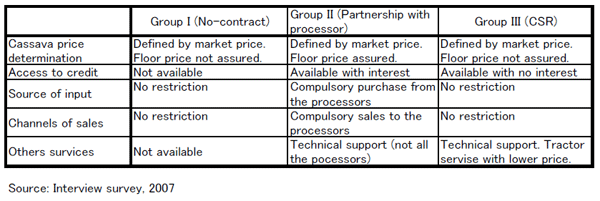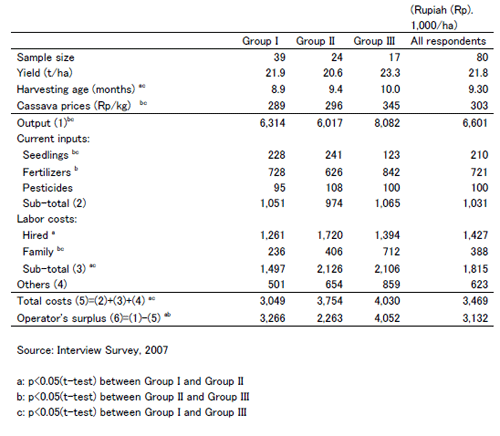The relationship between the cassava farmers-processors partnership and farmers’ productivity: A case study in Lampung Province, Indonesia.
Description
This study tries to identify the relationship between the partnership of farmers and processing companies, and the profits (income) of the small-scale cassava farmers in Lampung Province of Indonesia. A total of 80 cassava farmers in Sukadana District, East Lampung Regency, and Lampung Province were interviewed from February to March 2007. The respondents were classified into three groups; namely, Group I (without any contracts with the cassava processors), Group II (has a partnership with local cassava processors) and Group III (has a partnership with a Japanese food company which is implementing technical collaboration as a Corporate Social Responsibility/CSR Project). The characteristics of each group are shown in Table 1.
The revenue of Group III is significantly higher than the other two groups (Table 2). The results indicate that partnership with the CSR Project positively affected the revenues of the farmers, because the yield and price of cassava increased. The latter (pricing) seems to work more critically because the yield differences among the three groups are not statistically significant. The cassava price of Group III is significantly higher than the other two groups.
The better quality of cassava and the freedom to select the market for the cassava are the major factors that influenced the increasing price of cassava in Group III. It is appropriate to assume that the quality (starch content) of cassava is determined by the harvesting age. This assumption is supported by the fact that there is a significant correlation between the cassava price and the harvesting age of cassava. The cassava harvesting ages Group II and III are significantly longer than that of Group I. This suggests that the technical support by the processors optimized the harvesting age and more farmers succeeded in harvesting cassava within an appropriate timetable. Though there is no significant difference in the harvesting ages between those of Group II and III, the cassava price of Group III is better than Group II. This suggests that the freedom to select the market for cassava in Group III contributed to the higher cassava price.
Various companies have shown interest in producing biofuel from cassava in Indonesia. It can be concluded that the increasing demand for cassava will attract more companies to enter the processing business, and the emergence of the newcomers and the success of the CSR Project by the Japanese company in the study area will motivate the local cassava processors to invest more to attract cassava farmers, that in turn will contribute to the farmers’ welfare through improved profits from cassava production.
Figure, table
-
Table 1. The characteristics of farmers-processors partnerships
-
Table 2. Cassava production costs and returns
- Affiliation
-
Development Research Division
- Classification
-
Technical B
- Term of research
-
FY2007(FY2006~2010)
- Responsible researcher
-
SUGINO Tomohide ( Development Research Division )
Mayrowani Henny ( Indonesian Center for Agricultural Socio Economic and Policy Studies )
- ほか
- Publication, etc.
-
Sugino, T. and Mayrowani, H. (2008): The relationship between the cassava farmers-processor partnership and farmers’ productivity: a case study in Lampung Province, Indonesia. The 103th Academic Meeting of the Japanese Society of Tropical Agriculture, 29th-30th March 2008
- Japanese PDF
-
2007_seikajouhou_A4_ja_Part1.pdf437.89 KB


